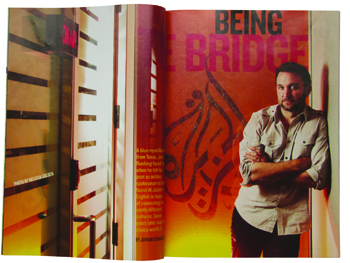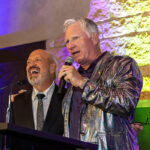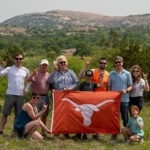Talk Back: Responses to our September|October Issue
 {November | December 2012}
{November | December 2012}
Jeff Wilson’s everything-but-the-football photo essay of the spectacle that is UT gameday brought the Longhorn spirit flooding in (“Beyond the Game,” September|October).
Susan Craven Dixon, BBA ’83, Life Member, spoke up for the Longhorn Band, asserting, “The football team couldn’t win without the band. They always ‘Come Early, Stay Late, Wear Orange’ and are definitely loud!” Bennett Jones added, “That’s the best band in the land right there! Love ’em enough that their rendition of ‘The Eyes of Texas’ is my ringtone.”
Laura Culbertson, BS ’01, had a different perspective, but equally enthusiastic one. “I work ‘behind the scenes’ of an NFL team,” she said, “and it’s all thanks to my time at UT back then. Blessings!”
A UT Medical School?
The prospect of UT-Austin building a medical school (“The Doctors Could Be In Austin”) drew both yeasayers and naysayers.
Michael W. Douglas, BJ ’90, wrote, “This would be a huge opportunity that could catapult Austin to the city of choice in the state of Texas.”
Greg White, MBA ’02, Life Member, wasn’t so sure about the means. “I think it could be a good thing, but I also think it shouldn’t be funded by raising Austin taxes again,” he said. “Need to look at alternate ways to make it happen.”
Elizabeth Panella Aronson, BA ’02, wanted even more than a standard medical school. “I would love for them to also have a PA program—here’s hoping!”
Joaquin Zamora, BBA ’94, Life Member, spoke up for South Texas, which is considering its own med school. “The 1.1 million Texans who live in the Lower Rio Grande Valley are still waiting for our medical school, and by the looks of it we’ll have to wait longer,” he noted. “This Texas Ex is not happy.”
ROTC On the Rise
 Proud graduates of UT’s ROTC programs were thrilled by the program’s coverage. Eric Remoy, BA ’93, wrote, “When I chose UT in the ’90s, everybody asked why I didn’t go to A&M if I intended to graduate as an Army officer. I went to UT for the quality of education and found a great home in the ROTC program.”
Proud graduates of UT’s ROTC programs were thrilled by the program’s coverage. Eric Remoy, BA ’93, wrote, “When I chose UT in the ’90s, everybody asked why I didn’t go to A&M if I intended to graduate as an Army officer. I went to UT for the quality of education and found a great home in the ROTC program.”
Michael Williams had a similar experience. “In 1975, I also was pushed to attend A&M, but there was no way I was going to be an Aggie. We only had 100 cadets in Air Force ROTC, but we kicked A&M’s tails in summer field training scores and commissioned outstanding officers. Concentrate on quality, and the numbers will take care of themselves.”
Phil Lehmberg, BBA ’74, Life Member, praised the cost-effectiveness of ROTC programs like UT’s. “My daughter attended West Point, and while it is a very good school, it’s a huge Pentagon expense. ROTC and [Officer Candidate School] programs turn out the largest percentage of the new military officers at a fraction of taxpayer cost. I hope UT’s ROTC program grows. It’s a win for all of us.”
Erika Griffith, BA ’92, Life Member, said ROTC programs could still use more support. “As an Air Force ROTC alumna, I find it telling that the University tore down Steindam Hall with the intent of sending the ROTC to the edge of campus. The University still treats ROTC like a redheaded stepchild. I am glad to hear about the veteran and community outreach and especially glad that, with alumni assistance, ROTC will be housed in one building.”
Horns Hoo-rah
Editor Lynn Freehill’s letter about UT’s long and proud military history warmed patriotic hearts—and prompted some ribbing of the Aggies.
Robert Dunlap said simply, “I’m so proud of the long and close relationship between UT and our military forces.”
Christine Van Meter, BA ’07, added a personal note: “Being a UT alum and meeting and marrying my four-times-over vet while attending, I find this fantastic.”
For David Repp, MPAff ’10, Life Member, it brought back memories. “I will never forget running ning around my Baghdad base with my buddy with a Longhorn flag, screaming like idiots after Texas beat USC. Iraqi guys working on the base started running around with us and had no idea why, but they loved it. I love telling my Aggie buddies that while they were playing dress-up soldier, I was doing the real thing.”
Katie Janda, BA ’11, wrote, “I love seeing our military pride and wish that we did more on campus to honor our veterans, active military, and those who died. We really do have a storied military history, and it needs to be promoted.”
Being the Bridge
 After reading our story on Josh Rushing, the Dallas native who left the Marines to help found Al-Jazeera English, several alumni wrote of their admiration.
After reading our story on Josh Rushing, the Dallas native who left the Marines to help found Al-Jazeera English, several alumni wrote of their admiration.
Ronald Boyce Walker, BS ’72, said, “I’m living in Paris these days and I watch this network regularly. A UT grad, huh? Fantastic.”
Keith Hall, BA ’89, MS ’92, added, “When I lived in New Zealand, Al Jazeera was by far the best news network around… It’s a bit harder to catch up now that I’m back in [Canada], but it’s a great news network. Who knew—a fellow Texas Ex?!”
Farewell to the Texas Exes Scholars
Joseph Washington’s personal essay about how a Texas Excellence Award altered his college experience caused Yvette Mirabal, BS ’99, to reflect on her own. “Such a wonderful experience, full of memories that are treasured,” she wrote. “I cannot sufficiently express my gratitude to Eleanor Kennon Moore and the generous alumni (especially Lowell Lebermann) who made the Texas Exes so much more than a simple scholarship program.”
Consider Class-Based Admission
Editor Lynn Freehill’s exploration of class-based admissions for making higher ed an equitable driver of upward mobility continued to draw reaction.
Humboldt Mandell, BS ’57, Life Member, wrote, “There is no perfect solution to admission. Like most, I hold the belief that students of all economic strata should have access to university education. But I will submit that the overriding admission criterion must be excellence. In using ‘class’ as a criterion, the University could be seen as focusing more on groups and less on individuals. Selection into this University should be based on the excellence of the applicant. Within every economic class, it is straightforward to measure excellence. Academic records must trump most everything else.”
Dustbusters
The good folks of the Harry Ransom Center took issue with the July|August issue’s description of their author’s door as “hidden away in a dusty fifth-floor hallway” (“Door Detective”). ” While it is in a dark hallway, we assure Alcalde readers that it is not dusty!” public affairs representative Alicia Dietrich, BJ ’04, Life Member, wrote. “The Ransom Center houses special collection materials, and great care is taken to ensure that optimal storage conditions are maintained. While the Ransom Center’s holdings are accessible to all, dust bunnies are not welcomed.”
Tweet of the Month
@Marimolina385 tweeted, “I picked up an issue this afternoon, and I’m in love with the design of the mag! Also love the way the cover feels!” Tweet us your feedback @TheAlcalde.
Corrections
September | October 2012
“Tracing Bevo” mislabeled the taurine breed of cattle. Also, the lab where Emily McTavish obtains data was misidentified—it is at the University of Missouri.
“The Doctors (Could Be) in Austin” neglected to depict the University of Texas Health Science Center at Tyler. Additionally, it mischaracterized Tom McHorse’s relationship to the Travis County Medical Society. He is a past president. The Alcalde regrets the errors.


















1 Comment